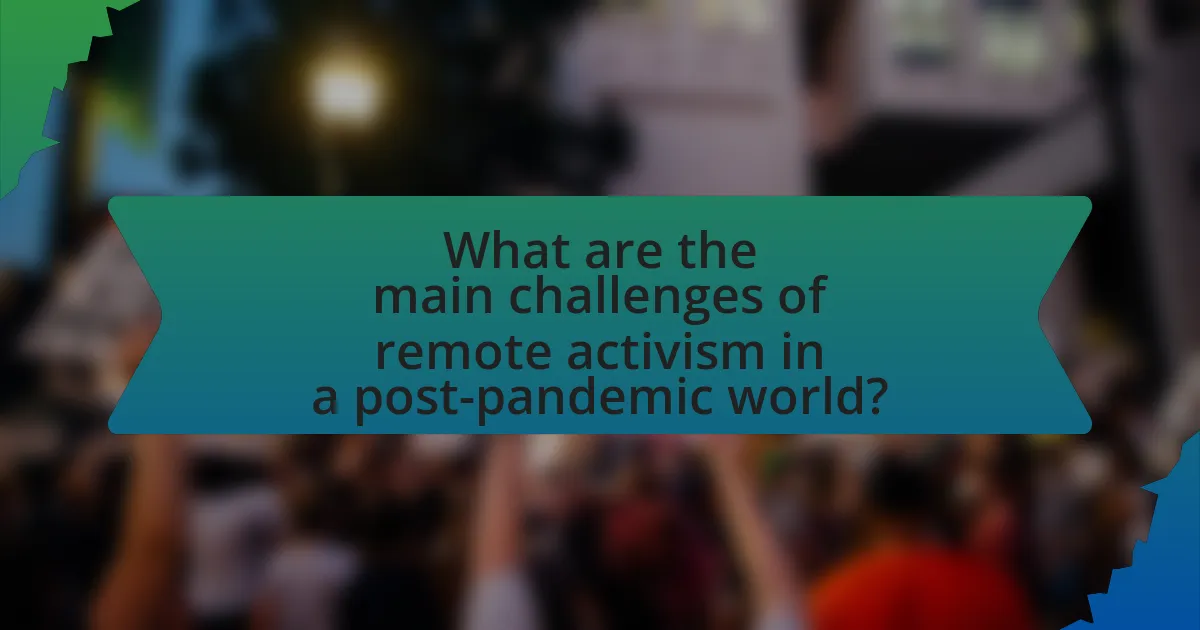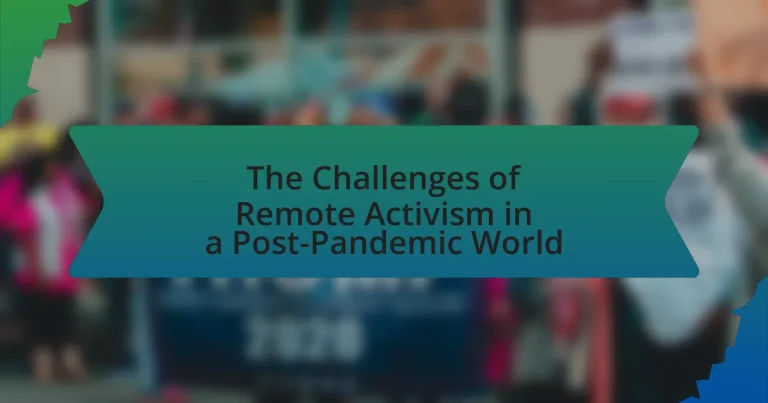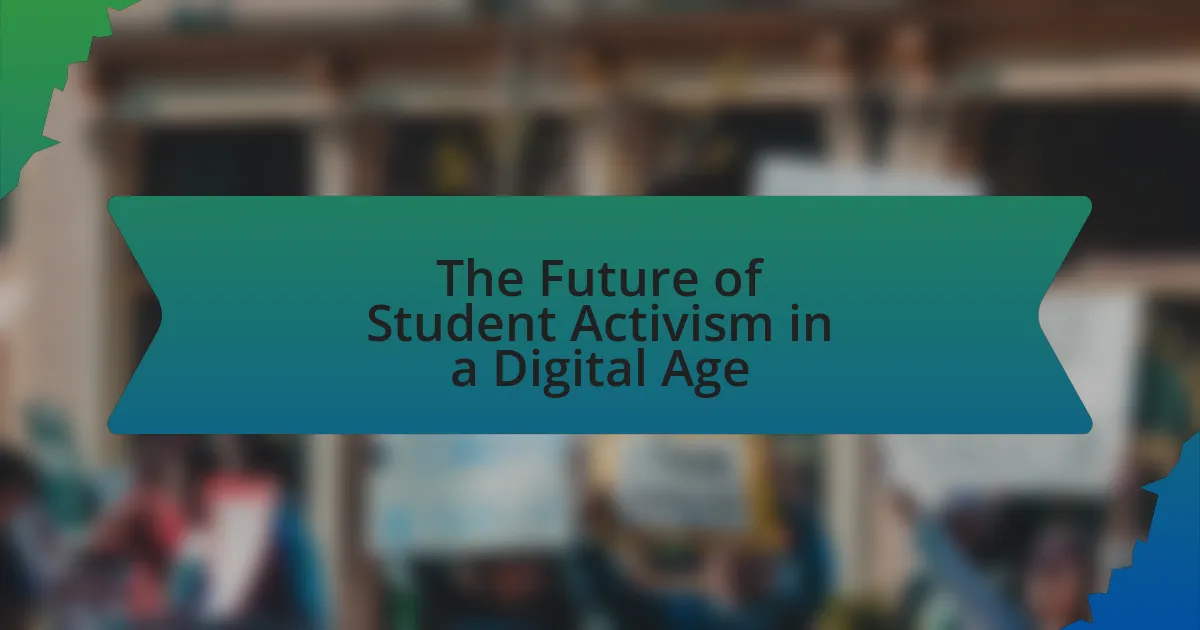The article examines the challenges of remote activism in a post-pandemic world, highlighting issues such as the digital divide, engagement fatigue, and the spread of misinformation. It discusses how the pandemic has accelerated the shift to digital platforms for organizing and mobilizing, while also introducing new barriers like increased digital surveillance and reduced in-person engagement opportunities. The role of technology in facilitating or hindering activism efforts is analyzed, along with the impact of government regulations and societal attitudes on online activism. Additionally, the article offers strategies for activists to overcome these challenges and explores the implications of remote activism for future movements.

What are the main challenges of remote activism in a post-pandemic world?
The main challenges of remote activism in a post-pandemic world include digital divide issues, engagement fatigue, and misinformation. The digital divide affects access to technology and the internet, limiting participation for marginalized communities; for instance, a report by the Pew Research Center indicates that 25% of adults in lower-income households lack reliable internet access. Engagement fatigue arises as activists struggle to maintain momentum and interest in online campaigns, particularly after prolonged periods of virtual interaction during the pandemic. Misinformation complicates the landscape, as false narratives can spread rapidly online, undermining the credibility of genuine activism efforts. These challenges collectively hinder the effectiveness and inclusivity of remote activism in the current environment.
How has the pandemic reshaped the landscape of activism?
The pandemic has significantly reshaped the landscape of activism by accelerating the shift towards digital platforms for organizing and mobilizing. Activists have increasingly utilized social media and online tools to reach broader audiences, as physical gatherings were restricted due to health concerns. For instance, the Black Lives Matter movement gained unprecedented global traction through online campaigns and virtual events during the pandemic, demonstrating the effectiveness of digital activism. Additionally, research from the Pew Research Center indicates that 53% of U.S. adults engaged in activism online during the pandemic, highlighting a notable increase in digital participation. This transition has not only expanded the reach of activist movements but also introduced new challenges, such as digital divide issues and the need for cybersecurity measures.
What new barriers have emerged for activists during and after the pandemic?
New barriers that have emerged for activists during and after the pandemic include increased digital surveillance, reduced in-person engagement opportunities, and heightened misinformation. Digital surveillance has intensified as governments and corporations monitor online activities, making it riskier for activists to organize and communicate. The pandemic led to restrictions on gatherings, limiting traditional forms of activism such as protests and community meetings, which are essential for mobilization and solidarity. Additionally, the proliferation of misinformation during the pandemic has complicated activists’ efforts to convey accurate information and rally support, as false narratives can undermine their causes and create confusion among the public.
How has the shift to remote activism affected participation rates?
The shift to remote activism has generally increased participation rates by making activism more accessible to a broader audience. Online platforms have enabled individuals who may have faced barriers to in-person participation, such as geographical limitations or health concerns, to engage in activism from their homes. For instance, a study by the Pew Research Center in 2021 found that 53% of Americans reported participating in online activism, a significant increase compared to previous years. This shift has allowed for greater mobilization and engagement, particularly among younger demographics who are more comfortable with digital communication.
What role does technology play in remote activism?
Technology serves as a crucial enabler of remote activism by facilitating communication, organization, and mobilization among activists. It allows individuals to connect across geographical boundaries, share information rapidly, and coordinate actions through platforms like social media, messaging apps, and video conferencing tools. For instance, during the COVID-19 pandemic, movements such as Black Lives Matter utilized technology to organize protests and raise awareness globally, demonstrating its effectiveness in reaching wider audiences. Additionally, data from the Pew Research Center indicates that 69% of Americans believe social media is an important tool for activism, highlighting its significant role in shaping public discourse and engagement.
How do digital platforms facilitate or hinder activism efforts?
Digital platforms facilitate activism efforts by providing widespread access to information and enabling rapid communication among activists. These platforms allow for the organization of events, mobilization of supporters, and dissemination of messages to a global audience, exemplified by movements like Black Lives Matter, which gained momentum through social media channels. Conversely, digital platforms can hinder activism by creating echo chambers that limit exposure to diverse viewpoints and by enabling misinformation, which can undermine the credibility of movements. For instance, studies have shown that misinformation can spread faster on social media than factual information, complicating the efforts of activists to convey their messages accurately.
What are the risks associated with online activism?
The risks associated with online activism include data privacy breaches, online harassment, and the potential for misinformation. Data privacy breaches occur when activists’ personal information is exposed, leading to threats or doxxing, as seen in cases where activists have been targeted by opposing groups. Online harassment can manifest through cyberbullying or coordinated attacks, which can deter individuals from participating in activism. Additionally, misinformation can spread rapidly on social media platforms, undermining the credibility of movements and leading to public confusion, as evidenced by the challenges faced during various social movements where false narratives gained traction.
How do social and political factors influence remote activism?
Social and political factors significantly influence remote activism by shaping the environment in which activists operate and the tools they use. For instance, social media platforms, which are crucial for remote activism, are affected by government regulations and policies that can either facilitate or hinder communication. In countries with restrictive political climates, such as China, activists face censorship and surveillance, which limits their ability to organize and mobilize effectively. Conversely, in more open societies, activists can leverage social media to raise awareness and build coalitions, as seen during movements like Black Lives Matter, where online campaigns led to widespread offline protests. Additionally, social factors such as community support and public sentiment can drive the success of remote activism, as seen in the global response to climate change, where collective social movements have gained traction through digital platforms.
What impact do government regulations have on online activism?
Government regulations significantly impact online activism by shaping the legal framework within which activists operate. These regulations can either facilitate or hinder the ability of individuals and organizations to mobilize support, share information, and organize protests. For instance, laws that protect freedom of speech and assembly can empower activists by allowing them to express dissent and rally support without fear of censorship or reprisal. Conversely, regulations that impose restrictions on online speech, such as anti-terrorism laws or content moderation policies, can stifle activism by limiting the platforms available for communication and organizing. A notable example is the implementation of the Digital Security Act in Bangladesh, which has been criticized for curbing online dissent and leading to arrests of activists, thereby illustrating how government regulations can suppress online activism and create a chilling effect on free expression.
How do societal attitudes towards activism change in a remote context?
Societal attitudes towards activism in a remote context often shift towards increased acceptance and participation due to the accessibility of digital platforms. Remote activism allows individuals to engage from their homes, leading to broader participation across diverse demographics, as evidenced by the surge in online movements like Black Lives Matter and climate activism during the COVID-19 pandemic. Research indicates that 70% of participants in online activism reported feeling more empowered to voice their opinions compared to traditional methods, highlighting a significant change in societal engagement with activism in remote settings.
What strategies can activists adopt to overcome these challenges?
Activists can adopt digital engagement strategies to overcome challenges in remote activism. Utilizing social media platforms effectively allows activists to reach wider audiences, mobilize support, and create awareness about their causes. For instance, campaigns like #BlackLivesMatter have successfully leveraged Twitter and Instagram to galvanize global support and drive social change. Additionally, organizing virtual events such as webinars and online workshops can facilitate community building and knowledge sharing, as seen in the rise of online activism during the COVID-19 pandemic. These strategies not only enhance visibility but also foster collaboration among diverse activist groups, thereby strengthening their collective impact.
How can activists leverage social media effectively?
Activists can leverage social media effectively by creating targeted campaigns that engage specific audiences and promote actionable goals. By utilizing platforms like Twitter, Facebook, and Instagram, activists can disseminate information rapidly, mobilize supporters, and foster community engagement. For instance, the Black Lives Matter movement utilized social media to raise awareness and organize protests, resulting in a significant increase in public support and participation, as evidenced by the millions of posts and shares during key events in 2020. This demonstrates that strategic use of hashtags, visual content, and real-time updates can amplify messages and drive collective action.
What are best practices for building community in a remote environment?
Best practices for building community in a remote environment include fostering regular communication, creating inclusive spaces, and utilizing collaborative tools. Regular communication, such as weekly video calls or daily chat updates, helps maintain connections and keeps members engaged. Creating inclusive spaces involves ensuring that all voices are heard and valued, which can be achieved through structured discussions and feedback mechanisms. Utilizing collaborative tools like project management software and social media platforms facilitates teamwork and enhances interaction among community members. These practices are supported by research indicating that effective communication and inclusivity are critical for community cohesion, especially in remote settings.
What are the implications of remote activism for future movements?
Remote activism significantly influences future movements by enhancing accessibility and broadening participation. This shift allows individuals from diverse backgrounds to engage in activism without geographical constraints, as evidenced by the surge in online petitions and social media campaigns during the COVID-19 pandemic. For instance, the Black Lives Matter movement gained unprecedented global traction through digital platforms, demonstrating that remote activism can mobilize support and raise awareness on a large scale. Furthermore, remote activism fosters innovative strategies for organizing and collaboration, as seen in the use of virtual meetings and digital tools, which can lead to more efficient and inclusive movements. These implications suggest that future activism will increasingly rely on digital engagement, making it essential for movements to adapt to this evolving landscape.
How might remote activism evolve in the coming years?
Remote activism is likely to evolve through increased integration of technology, enhanced digital platforms, and greater global collaboration. As more individuals engage in activism online, tools such as social media, virtual reality, and blockchain technology will facilitate more immersive and secure forms of advocacy. For instance, the rise of decentralized platforms can empower activists by providing anonymity and reducing censorship, as seen with the use of blockchain for secure communication in movements like the Hong Kong protests. Additionally, the COVID-19 pandemic has accelerated the shift towards virtual events, leading to a more inclusive environment where activists from diverse backgrounds can participate regardless of geographical barriers. This evolution will likely result in more coordinated global efforts, as evidenced by the success of online campaigns like #BlackLivesMatter, which mobilized millions worldwide through digital means.
What lessons can be learned from the challenges faced during the pandemic?
The challenges faced during the pandemic highlight the importance of adaptability and resilience in activism. Activists learned to pivot strategies quickly, utilizing digital platforms to mobilize support and maintain engagement. For instance, the surge in online petitions and virtual events demonstrated that grassroots movements could thrive despite physical distancing measures. Additionally, the pandemic underscored the necessity of addressing systemic inequalities, as marginalized communities faced disproportionate impacts, prompting a more inclusive approach in advocacy efforts. These lessons emphasize the need for innovative solutions and collaboration in future activism endeavors.
What practical tips can enhance remote activism efforts?
To enhance remote activism efforts, activists should leverage social media platforms effectively to reach a broader audience. Utilizing targeted campaigns on platforms like Twitter, Facebook, and Instagram can increase visibility and engagement, as evidenced by the success of movements such as Black Lives Matter, which gained significant traction through strategic online outreach. Additionally, organizing virtual events, such as webinars and online rallies, can foster community and mobilize supporters, as demonstrated by the rise of digital activism during the COVID-19 pandemic, where many organizations adapted to online formats to maintain momentum. Finally, collaborating with influencers and established organizations can amplify messages and resources, leading to greater impact and awareness.




